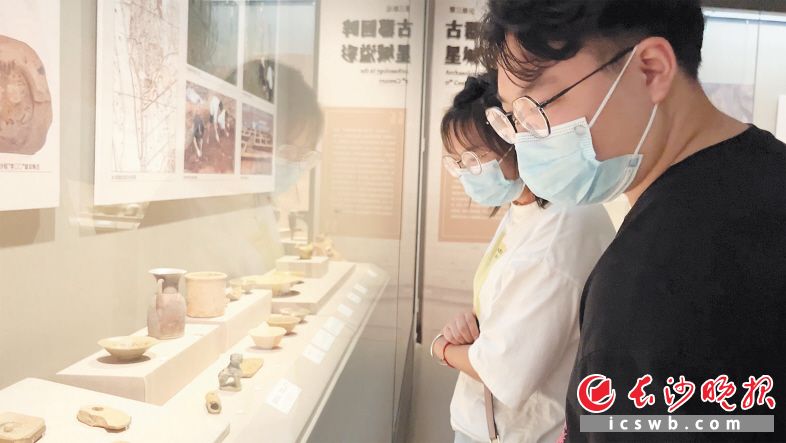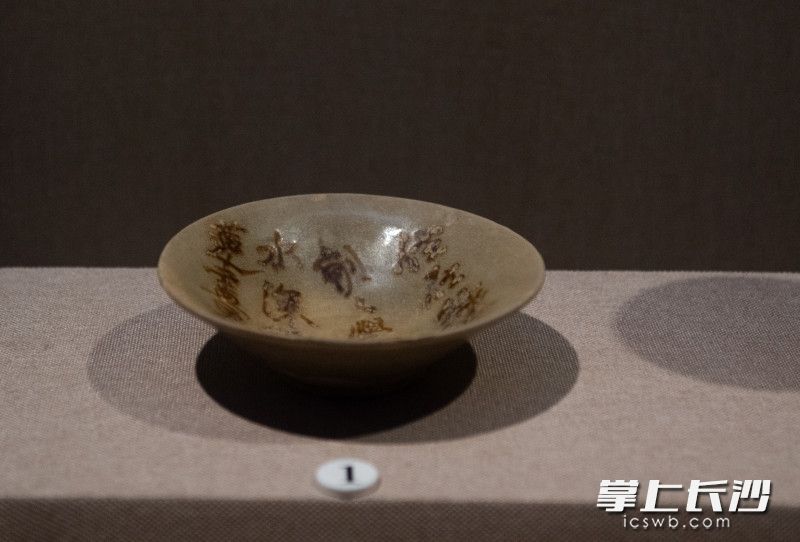In the special exhibition "Discoveries - A Review of 70 Years of Archaeological Finds in Changsha" held in the first hall of Changsha Museum, there is a porcelain bowl from Changsha kiln with a poem written on it, which is believed to be an unrecorded five-character poem in "Complete Tang Poems".
To understand more about this poem, the reporter specially invited the Deputy Director of Changsha Museum, Zhang Haijun, to introduce this poem which readers think is a new discovery. Zhang Haijun said that this poem from Tang dynasty was found in 1999 during an excavation by Changsha Cultural Relic and Archaeology Research Institute of the Lananzui Kiln Area of the Wangcheng Tongguan Official Kiln in Changsha. The poem is a "Lotus-picking" poem. Zhang Haijun recited the poem, “By the green pond's edge I reside, every day I learn to pluck the lotus. The water is deep and the lotus is hard to pick, but the boat moves on.”

Citizens visit the cultural relic exhibition at Changsha Museum. All photos were taken by reporter Zou Lin of Changsha Evening News.
Zhang Haijun said that this porcelain bowl with "Lotus-picking Poem" has a height of 4 cm, a diameter of 13.5 cm, and a bottom diameter of 5.3 cm. The bowl has an open mouth, a slanting abdominal wall, and a circular bottom. It is covered with blue glaze and the glaze does not reach the bottom. Inside the bowl, there is a five-character poem "Lotus-picking poem" written in brown color. The bowl was originally kept in Changsha Cultural Relic and Archaeology Research Institute, and it is the first time it is exhibited to the public during this exhibition at Changsha Museum.
Zhang Haijun further introduces that this newly discovered poem from the Tang Dynasty is not the only one that is not found in the "Complete Tang Poems" among the poems found on the Changsha Kiln. According to statistics, there are currently more than 100 poems found on the Changsha Kiln ceramics that are not found in the "Complete Tang Poems", and the content of the poems involves drinking, education, folk stories, and parting. After the "Lotus-picking Poem" was found on a ceramic bowl excavated from Lananzui area in 1999, relevant cultural relic workers immediately checked the "Complete Tang Poems" and discovered that it was a lost poem. The "Lotus-picking Poem" was already popular during the Han dynasty and became popular among society during the Tang and Song dynasties because of the popularity of lotus-picking songs and dances in the city's song and dance halls. However, the "Lotus-picking Poem" found in Lananzui area is not a song reflecting love life, but rather a poem reflecting the folk customs and customs of the southern watery towns, and is in the same vein as the famous Han dynasty folk song "Lotus can be Picked in Jiangnan," depicting a picture of life in the southern water towns, where the lotus flowers reflect the red on the faces of the beauty, showing the author's happy attitude towards life. "The water is deep and the lotus is hard to pick, but the boat moves on," "boat" is the same as "ship," these two lines of poetry depict the scene of lotus picking life and contain the charm of aphoristic style. This poem, written in a dark color on the inside of a Changsha Tongguan Kiln's ceramic bowl, makes people think of the beautiful life that once "filled" the Changsha area of the southern Jiangnan region during the Tang dynasty. At that time, the Changsha area belonged to Jiangnan, and it was far away from the turmoil of the Anshi Rebellion, and the social life was relatively peaceful. Since then, bowls and plates with poems written on them that reflect the interests of life in the Tang dynasty have become an important cultural relic.

This is a five-word character inscribed on a Changsha Kiln celadon ceramic bowl. It reads: "By the green pond's edge I reside, every day I learn to pluck the lotus. The water is deep and the lotus is hard to pick, but the boat moves on."
The Changsha Kiln, which was a kiln from the Tang Dynasty, is known for producing the famous "Changsha Kiln Porcelain" which began production in the early Tang Dynasty, flourished in the mid Tang Dynasty, and declined during the Five Dynasties period. It is a well-known type of porcelain that has gained international fame for its unique style among the "northern white and southern blue" porcelains. Currently, the Changsha Museum has the largest collection of ancient Changsha Kiln porcelain in the country. The exhibition "Discovery - A Review of 70 Years of Changsha Archaeology" at the Changsha Museum, which is currently on display, features many pieces of Changsha Kiln porcelain from the Tang Dynasty, which come from institutions such as the Changsha Cultural Relic and Archaeological Research Institute, the Changsha Museum, and the Changsha Kiln Museum. This newly discovered poem, "Lotus-picking Poem," which is not found in the "Complete Tang Poems," is an archaeological discovery from the Changsha Cultural Relic and Archaeological Research Institute. This discovery fills a gap in the collection of poems found on Changsha Kiln porcelain and has significant cultural value.